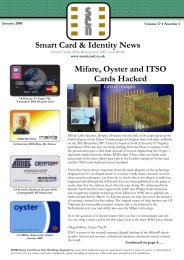Newsletter - June 1997 - Smart Card News
Newsletter - June 1997 - Smart Card News
Newsletter - June 1997 - Smart Card News
You also want an ePaper? Increase the reach of your titles
YUMPU automatically turns print PDFs into web optimized ePapers that Google loves.
<strong>Smart</strong> <strong>Card</strong> Tutorial<br />
Left:<br />
Figure 2<br />
Symmetric Cryptography<br />
In the case of asymmetric algorithms the situation is very<br />
different. These algorithms are often referred to as public<br />
key cryptography because of the way they are used. Lets<br />
see how this works in practice:<br />
In this example the transmitter uses an asymmetric<br />
algorithm such as RSA and with the receivers public key<br />
generates a cipher from the input message. This cypher<br />
is then transmitted across the network to the receiver. By<br />
using his secret key the receiver is able to receive the<br />
original message. Clearly the public and secret key of<br />
the receiver are mathematically related but the strength<br />
of the process relies on the difficulty of computing the<br />
secret key just from a knowledge of the public key. We<br />
note the use of the word “Difficulty” in practice few<br />
things are impossible but we can make it sufficiently<br />
difficult that the computation of the secret key is not<br />
economically viable. In practice this is largely determined<br />
by the length of the key which is why this receives so<br />
much attention in the media. Lets make a few<br />
observations:<br />
A<br />
B<br />
The receiver doesn’t know who sent the message<br />
( assuming the public key was truly made public )<br />
Although the transmitter doesn’t care about keeping the<br />
receivers public key secret he does care about its authenticity.<br />
If he used an eavesdroppers public key his message would be<br />
revealed.<br />
Lets take figure 3, below and reverse the process (figure<br />
4, overleaf):<br />
In this case the transmitter uses his secret key to obtain<br />
a transformation of the input message. This cipher is then<br />
sent across the network to the receiver who recovers the<br />
original message using the transmitters public key. Lets<br />
make some more observations,<br />
C<br />
D<br />
E<br />
The receiver knows that the message could only have come<br />
from a particular transmitter because nobody else has his<br />
secret key ( assuming he looks after it )<br />
Anybody with access to the transmitters public key can read<br />
the message<br />
The receiver needs to be assured to the genuineness of the<br />
transmitters public key in order to be sure that the message<br />
really did originate with that particular transmitter.<br />
Left:<br />
Figure 3<br />
Asymmetric Cryptography<br />
<strong>June</strong> <strong>1997</strong> <strong>Smart</strong> <strong>Card</strong> <strong>News</strong> 117
















